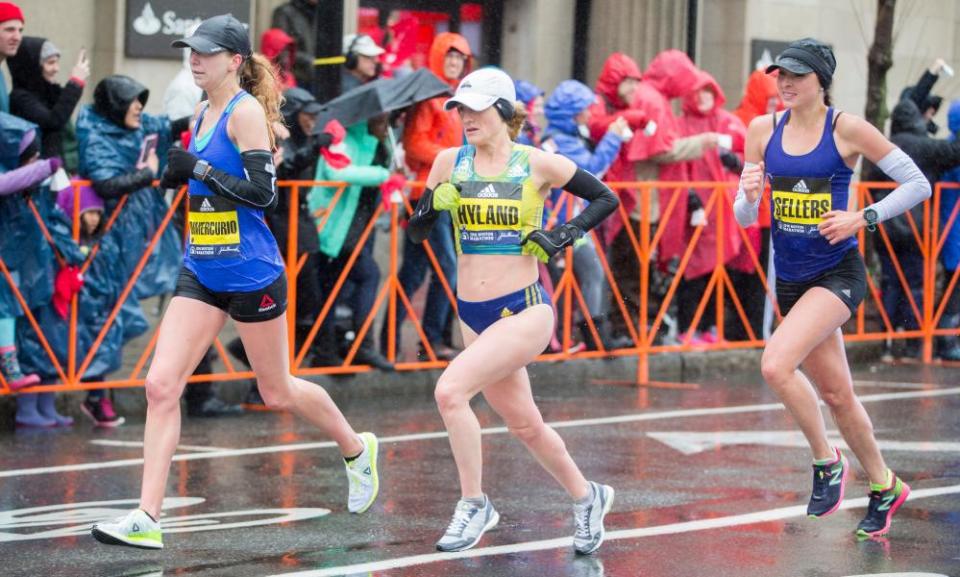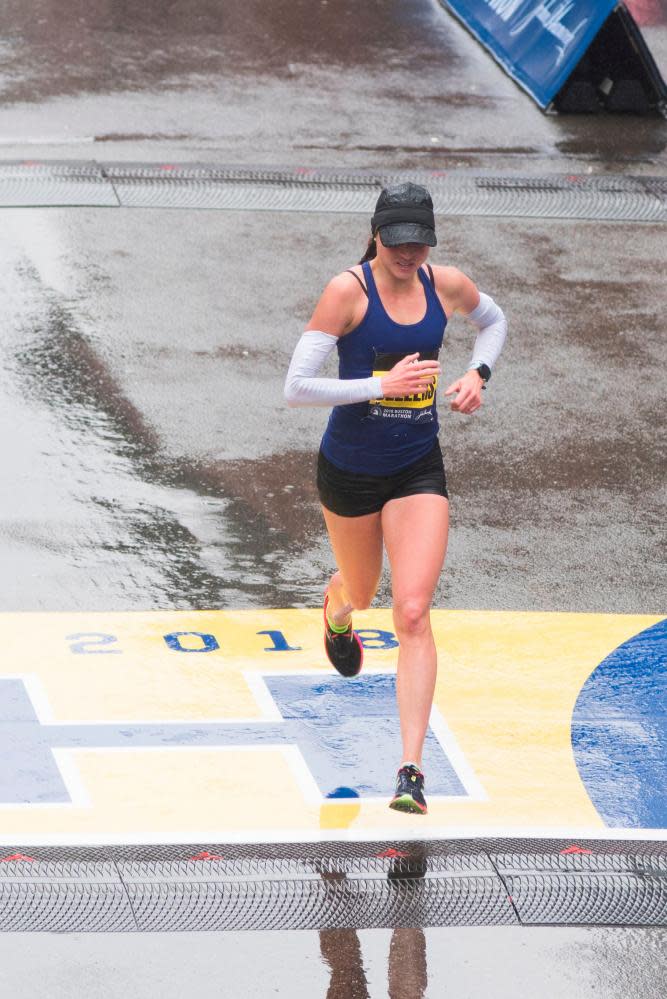Sarah Sellers: the nurse who stunned the world at the Boston Marathon

The story was so good it seemed impossible to imagine. A 26-year-old woman with no sponsors or agents, who had run only one marathon in her life, finished second in Monday’s Boston Marathon, one of the world’s most prestigious road races. And no sooner had she crossed the finish line did the question begin to buzz down Boylston Street.
Who is Sarah Sellers?
The amateur who trains by herself before or after shifts at a full-time nursing job has burst from total anonymity, becoming an overnight sensation in the running world. But across the country, Paul Pilkington, the women’s track coach at Weber State University in Ogden, Utah, laughs into his phone.
“If all those people at the race had only known her maiden name they might have been able to look her up and see she was pretty good in college,” he says.
Sarah Callister was a very fast runner at Weber State and how she got from there to Boston is even a better story than her improbable finish in Monday’s marathon. It’s a tale of agony and perseverance and the will to do something great even when nothing seems right.
“She’s just a tough lady,” Pilkington says.
Pilkington found her, years ago, running for the Ogden High School team and saw enough potential to recruit her to Weber State, where she quickly grew into one of the country’s fastest distance runners. By the winter of 2013, midway through her junior year, she was running well enough to believe she could be could be an All-American in the 10,000m when she began to feel pain in her left foot.
When her father, an orthopedic surgeon, warned she might be developing a stress fracture, he suggested she rest. Only she couldn’t rest: it was indoor track season and her times were too good to stop. She tore off at a blazing pace in a 5,000m race at the University of Washington, running so well that Pilkington thought she might set a school record. Then, late in the race, the gnawing pain burst into an inferno of ache that scorched through her foot. She slowed, falling from first to second, to third, to fourth, to fifth and finally sixth.
“I knew I needed to finish,” Sellers said this week by phone from her home in Tucson, Arizona.
But also, she realized, something was wrong.
She had broken the navicular, a small but significant bone on the top of her left foot. She understood enough about foot structure to know the injury was serious and that the prognosis was not good. The bone would heal but she probably couldn’t run competitively or for distance again.
“I was heartbroken,” she says. “Really, since before high school, every day that I could run I would go run. Now people were saying: ‘Maybe you should pick up art.’ I love art but I’m not a person who can sit and read or sit and do art. I have to be moving. I have to be running.”
Hoping to let the bone heal, Sellers gave up running. She stopped training with the Weber State team, missing her senior season. After college she went to graduate school and then to school to be a nurse anesthetist. She got married. She moved to Tucson with her husband, Blake, a doctor. She got a nursing job. Finally, four years after stopping, she tried running. Nothing big, just short distances. Something amazing happened. Her foot didn’t hurt. She ran a little more. Her brother, Ryan Callister, a runner as well, mentioned that he was training for the Boston Marathon. She thought she might want to do that too.
Last September, she entered a marathon in Huntsville, Utah, just outside of Ogden. Though she had only run 50 to 60 miles a week before the race she set a course record, finishing in 2hr 44min 27sec, qualifying her for Boston. The result emboldened her but she wasn’t sure what the time really meant. The Huntsville race is mostly downhill, descending from a 9,000ft peak in the Utah mountains. Running down a mountain is different from running against the world’s best on the hilly roads of Boston.
Sellers called Pilkington and asked for help preparing for Boston. They talked once a week by phone, the coach delivering a running plan for the next seven days. It was not an ideal arrangement. Unable to watch her run, Pilkington could only go off the times she gave him. She was running by herself, usually after work, when she was mentally exhausted. Most top marathoners train with other top runners, each pushing each other to be better. Sellers had only herself and the searing desert heat.
“I wasn’t going to use any of that as an excuse for not putting in a good workout,” she says. She kept pushing forward.
Neither Sellers nor Pilkington expected brilliance in Boston. Their best hope was she could finish in the top 10 and run below 2hr 45min, the time she needed to qualify for the US trials before the 2020 Olympics. Race day was awful. Rain poured down, a gloomy fog lingered over the course. A fierce wind whipped through the streets. No matter what direction she ran she felt as if it was blowing in her face.
Everybody was slow. Sellers’s times were below what she wanted, but with the wind there as nothing she could do. She figured there were about 15 women ahead of her but she couldn’t be sure. Toward the end of the race the cheering around her grew louder. She heard fans yelling, urging her on. The wind blew harder. She kept running.
At the finish line, she glanced up at her time: 2hr 44min 04sec. She saw a woman who appeared to be a race organizer and asked what place she had finished.
“Second,” the woman said.
“Are you serious?” Sellers cried. “There’s no way I came in second.”
The woman assured her she had finished second.
“You can’t be serious,” Sellers repeated.
“Second,” the woman said.

Later, she learned, that many of the women in front of her had dropped out. The wind and the rain were too much. The others, she had passed along the way.
“She’s just so tough,” Pilkington says, repeating a word he has found himself using over and over when talking about Sellers. “Those conditions grind you down. She just fought through them.
But then again, how many other top runners that day had felt the ache in their feet, seen the X-ray and been told they would never run again? How many had their dreams smashed only to prove they could still put a shoe to asphalt? A howling wind on a nasty, raw New England day wasn’t going to push her off the course. She had come too far to not run across that finish line, improbably cementing her status as an Olympic hopeful for Tokyo.
Now no one has to search for Sarah Callister to find Sarah Sellers. She has become a national story in the US: the woman who came from nowhere, appearing from the mist in Boston. Her name was all over television, radio, newspapers and the Internet. Then she and her husband flew back to Phoenix, where they had left their car, late Tuesday night. The car battery was dead. So much for fame.
On Thursday she went back to work, anonymous no more, and there was a celebratory chocolate cake waiting for – at 6.30am. It was hardly the breakfast of an elite marathoner but she didn’t mind. She bit into a piece of the chocolate goo.
“It’s been a long road,” she says into the phone.
Longer than anyone could imagine when her name flashed second on the leaderboard and the question – Who is Sarah Sellers? – captured the imagination of runners everywhere.

 Yahoo Sport
Yahoo Sport 





































